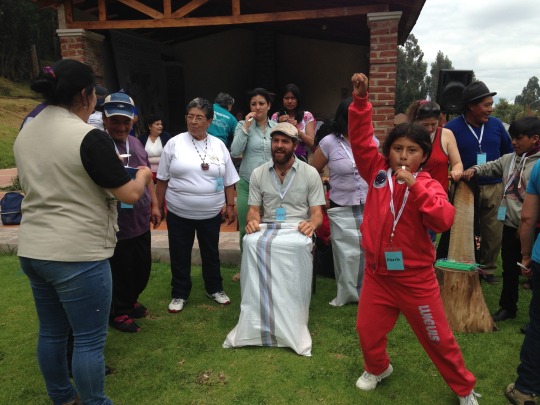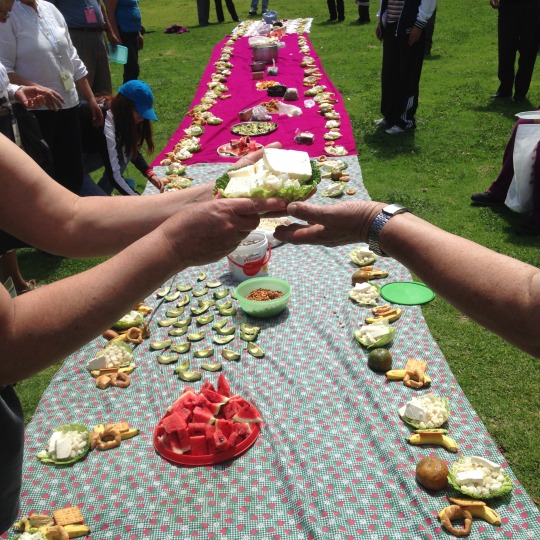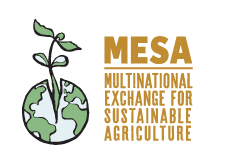By MESA Host and Forging Farmers 2013 Awardee Lucas Howerter
I haven’t done much traveling in Latin America in my life so far, but
last November I was offered an amazing opportunity to visit a close
friend in her home country of Ecuador. I met Fernanda when she was a
MESA steward a few years ago when we were interns for Ecology Action,
and we immediately became close friends. During that year Fernanda
shared with me her deep passion for her country, its people, its
culture, and its food, and ever since then I have dreamt of going.
On November 6th, 2015, I boarded a plane with my friend and longtime biointensive educator, Carol Cox, and headed for Fernanda’s home country. Carol and I went with the goal to see the
country and for Fernanda to share her little part of it with us.
During the first 2 weeks we were quickly immersed into the life of
the Ecuadorian Sierra while visiting farms, gardens, food shops, and
markets in every town. I was amazed by the amount of food that we
were constantly surrounded by. Unlike where I have lived back in the
States, at every corner you could buy real fresh food. Fruits of all
types and foods prepared by mothers or grandmothers in their homes
were sold on street corners.

Almost every turn you made there was a
new smell and shop selling some freshly made treat: hornado,
fritada, tortillas, and empanadas. But my favorite I have to say was the jugos
(juices)! At every meal there was a new jugo
to try, made fresh from whatever fruit was available. For such a
small country the regionality and culture of food was astounding. It
felt as if every time we entered a new town, village, or city the
first thing Fernanda would say was, “Oh we have to go find this or
that vegetable, bread, or dish because we will only find it here!”
A beautiful tapestry of foods so intertwined within the culture of
place.

With this
food diversity there must also be the growers, harvesters, and eaters
of course. A favorite farm we visited was El Molino
Farm, run by farmer Cesar Ayol and his 3 generations of family who
live there. I had heard of Cesar from Fernanda as she talked about
one of her favorite farmers who had helped build a lot of food
sovereignty into his community. As we arrived we were greeted by a
freshly prepared farm feast including their own homegrown trout.
While we ate and walked around his chakra
(garden in the Quichua
language), Cesar shared the story of his community, El Molino
as they went from landless workers on haciendas to proud and
independent farmers who have supported themselves since with minimal
outside aid. Fernanda further explained later that this community is
unique in its independence and resilience because, instead of
accepting outside aid and in turn becoming more dependent on it, they
chose to work together to create their own food sovereignty. They
have farmers, like Cesar, who believe the farm should first feed the
farmer and his/her community. Only then, should it share its extra
bounty for financial gains.

As
we traveled throughout Ecuador I felt this strength of community in
many areas, especially in ones more rural and agrarian-based. Less
than 36 hours after arriving in Ecuador, Carol and I were quickly
immersed into Fernanda’s community in celebrating the 15th
anniversary of the Canasta Comunitaria organization.
We were instantly welcomed, and after minutes I felt like I had
known the community for years. The group was made up of farmers,
consumers, and indigenous peoples of all ages.

It was wonderful to
watch and participate in the dancing, games, and fellowship they
shared. The celebration came to a close with a big feast called a
pamba mesa,
a traditional indigenous communal meal. I quickly felt at home and
loved helping everyone work and celebrate together.

Fernanda
has been working with Utopia since 2008, a community-focused
organization whose mission is
to promote food sovereignty, solidarity economy, and political
advocacy. Trying
to fulfill this mission, Utopia started
supporting a community project what they called Canasta Comunitaria,
or “community basket.” Their
goal is to link
agroecological and organic farmers with consumers in the city in a
fraternal relationship to strengthen their understanding of one
another.

The Canasta began in 2000 as a community-driven consolidation of farmers’ crops that are made
available for members to pick up biweekly. There are many
similarities with it and the CSA movement in the states. To share
with me, Fernanda took me to one of the días
de trabajo comunitario.
As we arrived on the little side street where the “dia
de trabajo comunitario”
was about to take place, it took me by surprise as not only the
consumers in the city but also the farmers themselves, with produce
and all, started arriving by city bus. With the look of joy on their
faces, men, women, and children of all ages, whether farmers or
eaters worked together to divide the bounty into shares and
distribute them to each member who came. I could see the feelings of
pride, sacredness, and connection each of them felt as they worked
together.


I had a
truly special time getting to see Ecuador through the lens of a
local, and it was wonderful to rekindle an old friendship. During my
time there, Fernanda shared with me a beautiful perspective of the
love one can have for one’s own country, its people, and its food. I
gained more inspiration and hope seeing so many people directly
connected to their food chain and the land that grows it. I can’t
wait to share what I have learned in my own community and continue my
own journey to learn how to strengthen people’s connection with the
food that gives them life.

